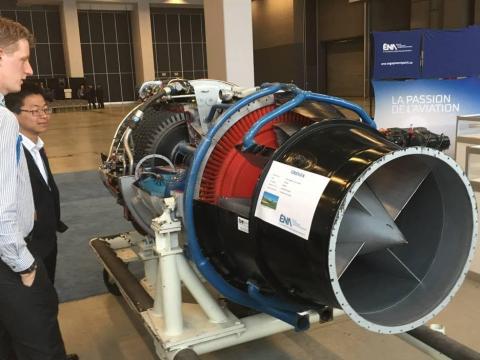Article
Gas turbines: Towards a more diverse operation
Author(s):
Turbomachinery Expo 2015 took place in June in Montreal, Canada under the auspices of the ASME’s International Gas Turbine Institute (IGTI).

Over 3000 participants were served up a choice of more than 1000 technical sessions covering the length and breadth of the turbomachinery landscape. Topics included supercritical CO2, surface coatings, steam turbines, combined cycle plant challenges, aircraft engines, combustion dynamics, turbochargers, vibration, compressor aerodynamics, wind power and more. The show even featured a historical exhibit of turbomachinery, especially early jet engines (Figure).
Perhaps the most valuable session in the whole show was part of the Electric Power track. Entitled, “User Experience with Gas Turbine Technology,” it provided the opportunity to hear exactly how major utilities harness GTs to provide power to their customers.
Rick Tomlinson, Turbine Fleet Reliability Engineer at Chevron Power and Energy Management, explained that a wide range of GTs used within the company and are used for many different types of duty including liquefaction, shipping, regasification, gas source power, gas processing and more. Chevron’s fleet amounts to 5,300 MW with an additional 2000 MW being built. From 100 gas turbines in 2012, this will expand to 141 by 2017.
“Gas turbines are important to our bottom line, being used in power generation, cogen and mechanical drive,” said Tomlinson. “They will be a larger part of our company in the coming years even though GTs are not our core business.”
This fleet is 30% heavy industrial turbines, mostly for power generation but their use in mechanical drive is growing; 60% would be classified as light industrial machines of 20 MW or less. They are mixed evenly between power and mechanical drive, and are mainly deployed in remote areas. The remaining 10% are aeroderivatives although this is an area Chevron expects to grow significantly in the next few years. Initially, these machines were deployed to produce power. But the mechanical drive portion is increasing.
“There are several new LNG facilities coming online, which will boost our aeroderivative fleet as well as our mechanical drive numbers,” said Tomlinson. “As our history has been in non-aeroderivative turbines, we are working to gain more expertise in this area.”
He manages this diverse fleet using a number of metrics. The service factor overall is 80%, with the top quartile being 92%. These machines, he said, are running 8000 or more hours per year. Another factor in fleet diversity is that Chevron has many 50 Hz and 60 Hz models. Further, there can sometimes be a 50Hz power island in a 60Hz country. This makes reliability even more critical. If it is running, the plant has no alternative.
“Our most important GT is one in sour gas injection which accounts for millions of dollars per hour if not running,” said Tomlinson. “The chairman of Chevron is informed on its maintenance intervals and schedules.”
As the fleet is subjected to continuous duty, downtime is always a challenge. The company uses a centralized fleet support model to deal with maintenance planning and execution, fleet reliability management, sharing of lessons learned and new project support. The GT team looks at what’s good in terms of turbine reliability and how to replicate that in other areas. Predictive analytic trending is done in Chevron’s monitoring and diagnostic center.
The most important key performance indicators are reliability and availability, followed by efficiency, heat rate and then capital parts lifecycle costs. Looking at the fleet as a whole, there is a lack of F-, G- and H-class turbines.
“We focus on the E-class as we have the expertise in that technology and don’t need to get into the higher classes,” said Tomlinson. “We like the reliability, familiarity and size of the E-class.”
You can read the rest of this article in the September/October issue of Turbomachinery International.
Newsletter
Power your knowledge with the latest in turbine technology, engineering advances, and energy solutions—subscribe to Turbomachinery International today.





